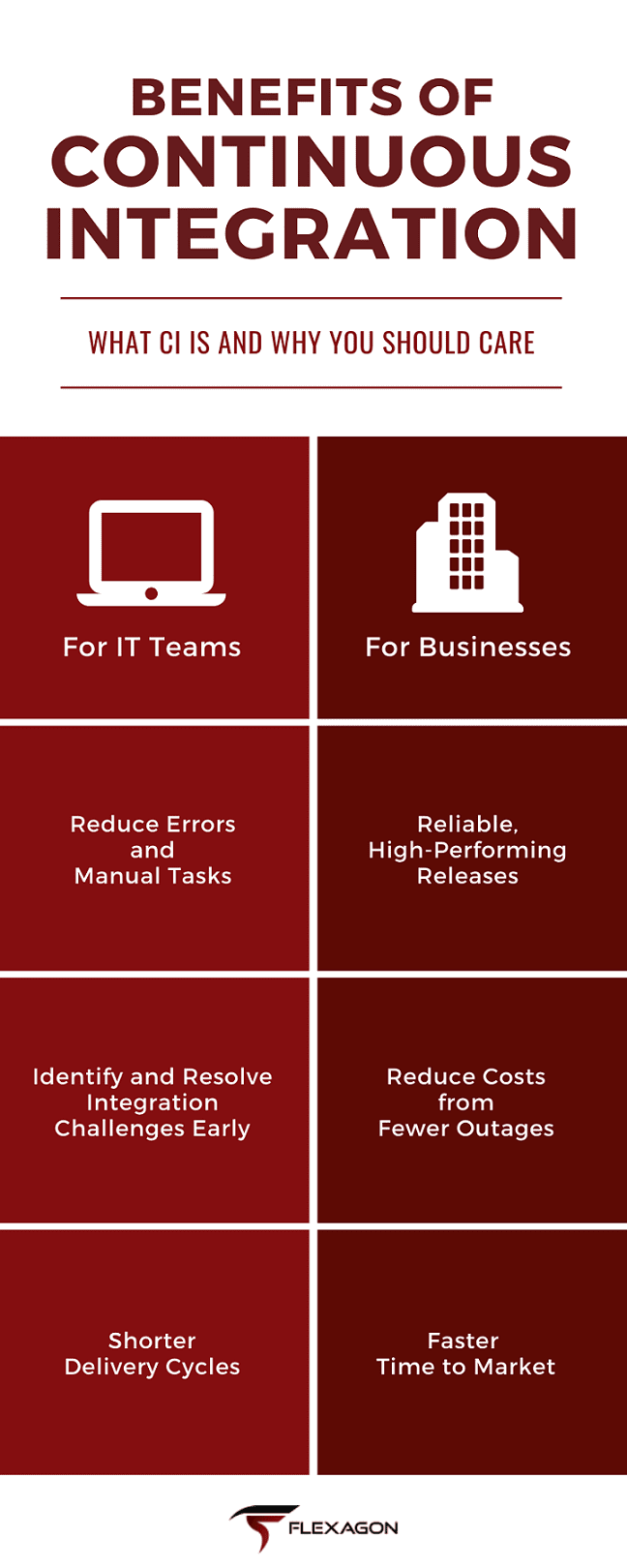Continuous Integration (CI) is a DevOps process where code is committed into source control and builds are automatically performed “continuously”. This speeds up and automates the software delivery life cycle (SDLC). However, the benefits of continuous integration extend much further.
Adopting continuous integration is a critical step for development teams to enhance their workflow. Software is a key competitive differentiator for companies across industries. The faster companies can get new enhancements and functionality to market, the wider their competitive edge. To achieve this lead, enterprise development teams need to optimize their workflow for efficiency, quality, and reliability through continuous integration and other agile processes.
Continuously integrating code improves processes in a way that benefits both IT teams and their business counterparts. In addition to the benefits inherent of continuous integration, it is integral to continuous delivery (CD) which offers even more advantages.
Benefits of Continuous Integration for IT Teams
Continuous integration repeatedly processes, tests, and uploads changes or additions made to a code base. The code is saved in a source control management system that is accessible to all developers for testing and reference. Any developer working on the application has access to the most current code. Continuous integration provides many benefits for IT teams, below are three of the most impactful for IT teams and their individual members.

1. Reduced Errors and Manual Tasks
Continuous integration requires teams to standardize processes and apply best practices so they can be easily repeated. Teams can then automate repeatable processes, thus reducing manual work and decreasing opportunities for human error. As teams focus less on manual tasks, they can devote more time to strategic initiatives and other high-value projects.
2. Identify and Resolve Integration Challenges Early
Traditionally, developers waited for longer periods of time (usually weeks or months) to integrate code and test code, not discovering problems until then. With continuous integration, developers build and test code regularly, integrating smaller chunks of code at a time. That makes it easier to identify issues quickly and pinpoint where the issue is. Developers can resolve problems immediately, instead of building code on top of an undetected issue.
Issue resolution and testing is further improved when teams implement the complete continuous delivery methodology because it requires teams to establish consistency across environments. As a result, teams resolve the common problems that arise with disconnected test and production environments. Code functions the same way in each environment, so it’s less likely teams will encounter a new problem after code is released to production.
3. Shorter Delivery Cycles
Continuous integration is part of the larger continuous delivery process, which focuses on pushing smaller batches of code from development to production faster. During continuous integration, code is committed to the source control management system more frequently, making it possible for teams to build, test, deploy, and release code more quickly. The result is a shorter delivery cycle that helps IT teams complete a higher number of smaller projects in less time.
Benefits of Continuous Integrations for Businesses
Continuous integration doesn’t just impact the IT teams that use it daily. It also has a significant impact on IT’s business counterparts, including software end users such as marketing and sales departments, business analysts, and customers. For business users, continuous integration improves access to the latest enhancement and technology that can drive businesses forward.
Here are three key benefits of continuous integration for businesses:
1. Reliable, High-Performing Releases
Continuous updates and test automation helps ensure reliable, high-quality releases that have fewer errors and bugs that could reduce their effectiveness. For end users, this translates to enhancements they can put to use more quickly to drive business growth.
2. Reduced Costs from Fewer Outages
Reduced manual tasks and errors also decreases the likelihood of outages or downtime after release. For end users, that provides a higher level of service and increases productivity, especially when continuous integration is extended to continuous delivery, where deployments occur automatically across test environments and into production. More importantly, however, it can drastically reduce costs as businesses won’t have to waste time and resources resolving outages.
3. Software is Delivered to Market Faster
Faster build times, more reliable code and tests, and reduced outages all translate to faster delivery of new enhancements to market for companies and their users – often as part of a larger continuous delivery process. Companies can use their enhanced functionality to improve products and services for their customers and gain a competitive advantage in the marketplace.
Continuous Integration Enables Continuous Delivery
Continuous integration is just one element of continuous methodologies. Most companies see the best benefits by implementing continuous integration within the larger framework of continuous delivery, creating a full CI/CD pipeline that drives improved business and IT performance.
The most important aspect of CI/CD, however, is to ensure you measure benefits not just in terms of your IT team, but through the lens of your business as well. The more closely your IT team is aligned with your business, the better.
Editor’s note: This post was originally published in October 2018 and has been updated as of November 2020 for freshness, accuracy, and comprehensiveness.




